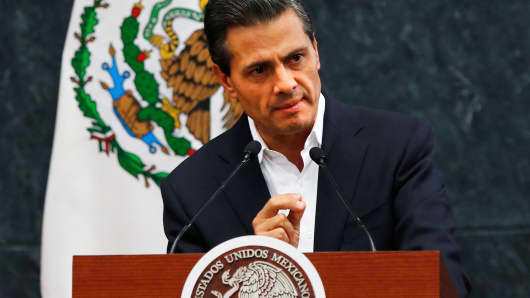Mexico's hard-won image as an emerging-market star has taken a pounding in recent weeks. Instead of focusing on groundbreaking economic reforms, media attention has shifted to the nation's darker side. The disappearance of 43 students is a reminder that Mexico's problem with corruption and organized crime has not gone away. A plunge in the oil price, which accounts for a third of government revenues, has also raised concerns about future growth.
But investors would be wise not to give up on Mexico. As emerging-market fortunes diverge, Mexico is still set to be among the leaders.
Since taking office in December 2012, Enrique Peña Nieto has been among the boldest economic reformers in the world. The state's 75-year monopoly on oil drilling — enshrined in the constitution and long seen as untouchable — has ended, opening the way for a surge in investment and production.
Read MoreMexico's 'tremendous' hedge: Oil is falling but this big producer isn't worried
Nor have reforms been limited to energy. Peña Nieto is dismantling a telecoms monopoly that cost Mexican consumers about $25 billion a year in higher prices. Around 34 laws have been amended to force more competition between financial institutions, which should help lower borrowing rates.
Finally, the tragic disappearance and presumed killing of the 43 students in the state of Guerrero occurred despite a noticeable decline in crime statistics in the past two years. The recent events are already leading to a redoubling of the administration's efforts to improve security.
Deep structural reforms don't produce growth overnight. But in 2015, Mexico should already start to reap the rewards of Peña Nieto's work.
Our research shows the country should expect a $50 billion surge in investments in oil and gas in the next four years, equivalent to about 1 percent of GDP per year. This is in addition to sizable expected investment in the energy sector by Mexican companies. A decade-long slide in oil production under state monopolist Pemex should start to reverse. Meanwhile, a decline in telecom prices will put extra cash in the pockets of consumers, helping to lift confidence.
Read MoreShould the US lift its oil-export ban?
Sound macro-economic policies and low inflation have also put Mexico's powerful manufacturing sector in a sweet spot. Hourly wages in Mexico are now around a fifth lower than those in China, a huge turnaround from a decade ago. As Chinese wages rise, Mexico's advantage is growing.
Energy costs for Mexican industry are also set to fall starting in 2015. A pipeline bringing cheap natural gas from U.S. shale fields, due for completion in late 2015, should cut the cost of electricity for industrial users. Since manufacturing is about a third of GDP, this has the potential to boost the overall growth rate substantially.
Even the recent dip in the oil price is not as much of a problem as feared by the markets. For a start, the Mexican government has hedged about half of its revenues at $79 a barrel for the coming year. And, while Mexico is the world's 10th largest crude exporter, its lack of refining capacity forces it to import gasoline. Net hydrocarbon exports account for a modest 0.46 percent of GDP.
Read MoreOp-ed: Here's the one person who can bail out Putin
Finally, Mexico seems to be in the right place at the right time. Around 80 percent of Mexico's exports go to the flourishing U.S. — which the IMF expects to be the fastest growing G7 nation in 2015. Low oil prices should boost the U.S. economy and increase demand for Mexico's exports, thus providing another oil price hedge. Record manufacturing exports, a pickup in construction and investment and increased hiring make Mexico one of the few economies showing a cyclical upswing into 2015.
Despite the country's achievements, Mexican stocks have actually fallen 10 percent in U.S. dollar terms year-to-date, compared with a 3-percent average decline for emerging markets. India, another country experiencing both structural reform and a cyclical recovery, has seen its equity market rally 22 percent this year. The peso has also depreciated 11 percent, making it one of the most attractively valued currencies in the world.
No doubt Mexico has much work to do, especially with respect to the rule of law. But the country's current travails offer an opportunity to get exposure to a positive long-term emerging market reform story that is far from priced into financial markets.
Commentary by Jorge Mariscal, emerging markets chief investment officer at UBS Wealth Management.


